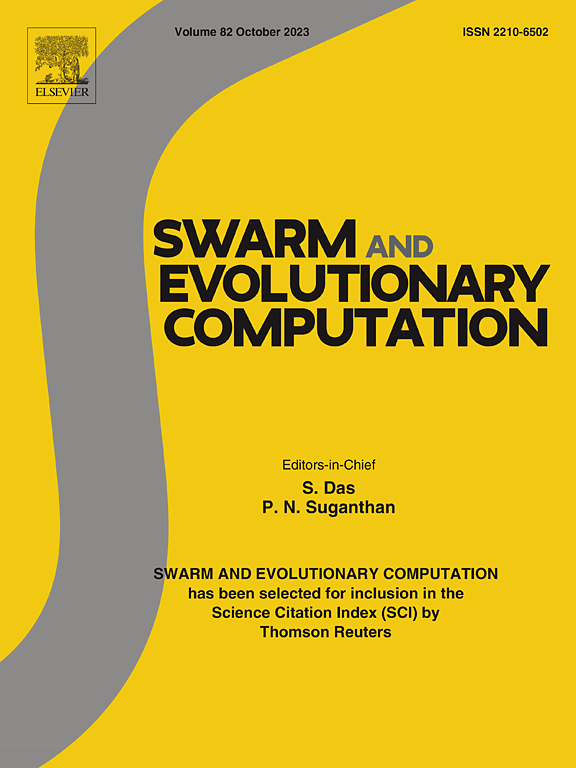Hiding region constraints for black-box optimization. Application to camera placement in a virtual industrial environment using Evolutionary Computation
IF 8.2
1区 计算机科学
Q1 COMPUTER SCIENCE, ARTIFICIAL INTELLIGENCE
引用次数: 0
Abstract
Many real-world optimization problems related to physical environments have heavily constrained search spaces, which hinders the direct application of meta-heuristics and similar black-box methods. This work describes how to avoid region constraints and self-adapt search spaces without renouncing competitive solutions. The proposal relies on defining a gateway function that hides environment-specific placement constraints and is compatible with regular meta-heuristics and simulation-based optimization. The function can show a standard box-constrained domain encapsulating the real places involved. It has been successfully applied to automatic camera placement for task observation in a particle accelerator. The environment and the process of interest are simulated in the Unity game engine, which defines a cutting-edge trend in the design of such facilities. The primary optimization method tested is the genetic algorithm of MATLAB’s Global Optimization Toolbox, an industry standard that achieves remarkable results. The widespread Teaching–Learning-Based Optimizer (TLBO) and a random search have also been tried to complement the study. According to the results, the proposal does not prevent the advanced optimizers from finding camera arrangements that outperform (and are validated by) a human expert. It also allows the random search to find reasonable arrangements despite the underlying intricate set of constraints.
隐藏区域约束的黑盒优化。进化计算在虚拟工业环境中摄像机放置中的应用
许多与物理环境相关的现实世界优化问题具有严重的搜索空间约束,这阻碍了元启发式和类似黑盒方法的直接应用。这项工作描述了如何在不放弃竞争解决方案的情况下避免区域约束和自适应搜索空间。该提案依赖于定义一个网关功能,该功能隐藏特定于环境的放置约束,并与常规的元启发式和基于模拟的优化兼容。该函数可以显示一个标准的盒约束域,封装了所涉及的实际位置。该方法已成功应用于粒子加速器任务观测中摄像机的自动定位。环境和感兴趣的过程是在Unity游戏引擎中模拟的,这在此类设施的设计中定义了一个前沿趋势。测试的主要优化方法是MATLAB全局优化工具箱中的遗传算法,这是一个取得显著效果的行业标准。广泛使用的基于教学的优化器(TLBO)和随机搜索也被用来补充研究。根据结果,该建议并没有阻止高级优化器找到优于人类专家(并经过验证)的摄像机布置。它还允许随机搜索找到合理的安排,尽管潜在的复杂的约束集。
本文章由计算机程序翻译,如有差异,请以英文原文为准。
求助全文
约1分钟内获得全文
求助全文
来源期刊

Swarm and Evolutionary Computation
COMPUTER SCIENCE, ARTIFICIAL INTELLIGENCEC-COMPUTER SCIENCE, THEORY & METHODS
CiteScore
16.00
自引率
12.00%
发文量
169
期刊介绍:
Swarm and Evolutionary Computation is a pioneering peer-reviewed journal focused on the latest research and advancements in nature-inspired intelligent computation using swarm and evolutionary algorithms. It covers theoretical, experimental, and practical aspects of these paradigms and their hybrids, promoting interdisciplinary research. The journal prioritizes the publication of high-quality, original articles that push the boundaries of evolutionary computation and swarm intelligence. Additionally, it welcomes survey papers on current topics and novel applications. Topics of interest include but are not limited to: Genetic Algorithms, and Genetic Programming, Evolution Strategies, and Evolutionary Programming, Differential Evolution, Artificial Immune Systems, Particle Swarms, Ant Colony, Bacterial Foraging, Artificial Bees, Fireflies Algorithm, Harmony Search, Artificial Life, Digital Organisms, Estimation of Distribution Algorithms, Stochastic Diffusion Search, Quantum Computing, Nano Computing, Membrane Computing, Human-centric Computing, Hybridization of Algorithms, Memetic Computing, Autonomic Computing, Self-organizing systems, Combinatorial, Discrete, Binary, Constrained, Multi-objective, Multi-modal, Dynamic, and Large-scale Optimization.
 求助内容:
求助内容: 应助结果提醒方式:
应助结果提醒方式:


